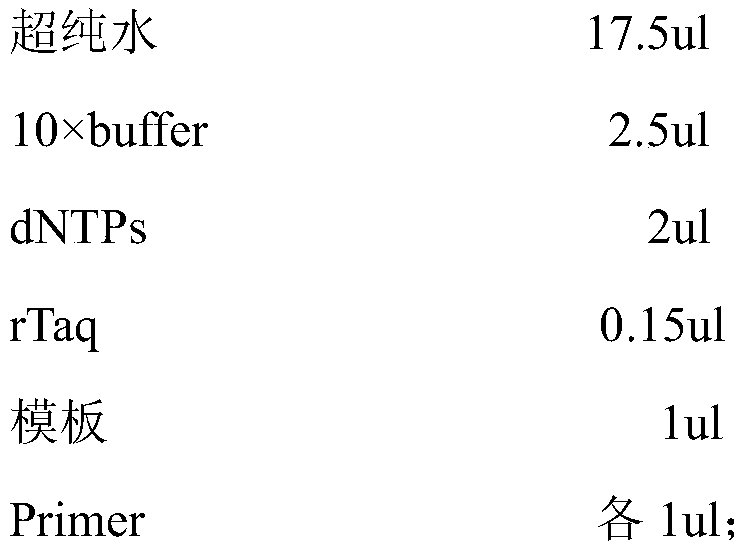Molecular marker for identifying sphyraena pinguis gunther from sphyraena putnamae and application of molecular marker
A molecular marker, inverted tooth sting technology, which is applied in the determination/inspection of microorganisms, biochemical equipment and methods, DNA/RNA fragments, etc. Avoid economic losses, high efficiency
- Summary
- Abstract
- Description
- Claims
- Application Information
AI Technical Summary
Problems solved by technology
Method used
Image
Examples
Embodiment 1
[0026] A molecular marker primer and its identification method for distinguishing oily beetle and mandarin beetle:
[0027] 1) The sample populations were selected from the species of the basilisk and the invertebrate collected in the Beibu Gulf, and the DNA of the two sample populations were extracted respectively;
[0028] 2) using the DNA extracted in step 1) as a template, and amplifying through the PCR reaction system with primer F and primer R respectively;
[0029] The composition of described PCR reaction system is:
[0030] Add in order to the 0.2ml centrifuge tube:
[0031]
[0032] The PCR amplification program was pre-denaturation at 94°C for 2 min, (denaturation at 94°C for 15 sec, annealing at 50°C for 15 sec, extension at 72°C for 15 sec) x 38 cycles, extension at 72°C for 3 min, and storage at 4°C for long-term storage.
[0033] 3) Purify and sequence the PCR products, and compare the sequencing results of the two populations to identify their species.
Embodiment 2
[0035] A molecular marker primer and its identification method for distinguishing oily beetle and mandarin beetle:
[0036] 1) The sample populations were selected from the species of the basilisk and the invertebrate collected in the Beibu Gulf, and the DNA of the two sample populations were extracted respectively;
[0037] 2) using the DNA extracted in step 1) as a template, and amplifying through the PCR reaction system with primer F and primer R respectively;
[0038] The composition of described PCR reaction system is:
[0039] Add in order to the 0.2ml centrifuge tube:
[0040]
[0041]
[0042] The PCR amplification program was pre-denaturation at 94°C for 4 min, (denaturation at 94°C for 35 sec, annealing at 53°C for 30 sec, extension at 72°C for 15 sec) x 30 cycles, extension at 72°C for 10 min, and storage at 4°C for long-term storage.
[0043] 3) Purify and sequence the PCR products, and compare the sequencing results of the two populations to identify their...
Embodiment 3
[0045] A molecular marker primer and its identification method for distinguishing oily beetle and mandarin beetle:
[0046] 1) The sample populations were selected from the species of the basilisk and the invertebrate collected in the Beibu Gulf, and the DNA of the two sample populations were extracted respectively;
[0047] 2) using the DNA extracted in step 1) as a template, and amplifying through the PCR reaction system with primer F and primer R respectively;
[0048] The composition of described PCR reaction system is:
[0049] Add in order to the 0.2ml centrifuge tube:
[0050]
[0051] The PCR amplification program was pre-denaturation at 94°C for 5 min, (denaturation at 94°C for 35 sec, annealing at 50°C for 35 sec, extension at 72°C for 35 sec) x 38 cycles, extension at 72°C for 10 min, and storage at 4°C for long-term storage.
[0052] 3) Purify and sequence the PCR products, and compare the sequencing results of the two populations to identify their species.
...
PUM
 Login to View More
Login to View More Abstract
Description
Claims
Application Information
 Login to View More
Login to View More - R&D
- Intellectual Property
- Life Sciences
- Materials
- Tech Scout
- Unparalleled Data Quality
- Higher Quality Content
- 60% Fewer Hallucinations
Browse by: Latest US Patents, China's latest patents, Technical Efficacy Thesaurus, Application Domain, Technology Topic, Popular Technical Reports.
© 2025 PatSnap. All rights reserved.Legal|Privacy policy|Modern Slavery Act Transparency Statement|Sitemap|About US| Contact US: help@patsnap.com



